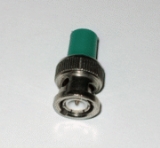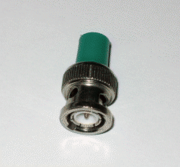
Electrical termination
Encyclopedia

Radio frequency
Radio frequency is a rate of oscillation in the range of about 3 kHz to 300 GHz, which corresponds to the frequency of radio waves, and the alternating currents which carry radio signals...
signal from being reflected back from the end, causing interference
Interference (communication)
In communications and electronics, especially in telecommunications, interference is anything which alters, modifies, or disrupts a signal as it travels along a channel between a source and a receiver. The term typically refers to the addition of unwanted signals to a useful signal...
. The terminator is placed at the end of a transmission line
Transmission line
In communications and electronic engineering, a transmission line is a specialized cable designed to carry alternating current of radio frequency, that is, currents with a frequency high enough that its wave nature must be taken into account...
or daisy chain
Daisy chain (electrical engineering)
In electrical and electronic engineering a daisy chain is a wiring scheme in which multiple devices are wired together in sequence or in a ring...
bus
Electrical bus
Electric bus is a bus powered by electric energy. "Electric bus" can also refer to:* Bus , used for connecting components of a computer or communication between computers* Busbars, thick conductors acting as nodes in electrical substations...
(such as in SCSI
SCSI
Small Computer System Interface is a set of standards for physically connecting and transferring data between computers and peripheral devices. The SCSI standards define commands, protocols, and electrical and optical interfaces. SCSI is most commonly used for hard disks and tape drives, but it...
), designed to match
Impedance matching
In electronics, impedance matching is the practice of designing the input impedance of an electrical load to maximize the power transfer and/or minimize reflections from the load....
impedance
Characteristic impedance
The characteristic impedance or surge impedance of a uniform transmission line, usually written Z_0, is the ratio of the amplitudes of a single pair of voltage and current waves propagating along the line in the absence of reflections. The SI unit of characteristic impedance is the ohm...
and hence minimize signal reflections.
Types of terminators
PassivePassive terminators consist of a simple resistor
Resistor
A linear resistor is a linear, passive two-terminal electrical component that implements electrical resistance as a circuit element.The current through a resistor is in direct proportion to the voltage across the resistor's terminals. Thus, the ratio of the voltage applied across a resistor's...
. Limited usage for highspeed applications. There are two types: a resistor between signal and ground like in Ethernet, or a resistor from the positive rail to signal and a resistor from the signal to negative rail like in SCSI
SCSI
Small Computer System Interface is a set of standards for physically connecting and transferring data between computers and peripheral devices. The SCSI standards define commands, protocols, and electrical and optical interfaces. SCSI is most commonly used for hard disks and tape drives, but it...
.
Active
Active terminators consist of a voltage regulator
Linear regulator
In electronics, a linear regulator is a voltage regulator based on an active device operating in its "linear region" or passive devices like Zener diodes operated in their breakdown region...
that keeps the voltage used for the terminating resistor(s) at a constant level.
Forced Perfect Termination (FPT)
Forced Perfect Termination can be used on single ended
Single-ended signalling
Single-ended signaling is the simplest and most commonly used method of transmitting electrical signals over wires. One wire carries a varying voltage that represents the signal, while the other wire is connected to a reference voltage, usually ground....
buses where diode
Diode
In electronics, a diode is a type of two-terminal electronic component with a nonlinear current–voltage characteristic. A semiconductor diode, the most common type today, is a crystalline piece of semiconductor material connected to two electrical terminals...
s remove over and undershoot
Overshoot (signal)
In signal processing, control theory, electronics, and mathematics, overshoot is when a signal or function exceeds its target. It arises especially in the step response of bandlimited systems such as low-pass filters...
conditions. The signal is locked between two actively regulated voltage levels, which results in superior performance over a standard active terminator.
SCSI
All parallel SCSISCSI
Small Computer System Interface is a set of standards for physically connecting and transferring data between computers and peripheral devices. The SCSI standards define commands, protocols, and electrical and optical interfaces. SCSI is most commonly used for hard disks and tape drives, but it...
units use terminators. SCSI is primarily used for storage and backup.
Controller Area Network
Controller area networkController Area Network
Controller–area network is a vehicle bus standard designed to allow microcontrollers and devices to communicate with each other within a vehicle without a host computer....
, commonly known as CAN Bus, uses terminators consisting of a 120 ohm resistor.
Ethernet coaxial 50 ohm
10BASE210BASE2
10BASE2 is a variant of Ethernet that uses thin coaxial cable , terminated with BNC connectors...
networks absolutely must have proper termination with a 50 ohm BNC terminator
BNC connector
The BNC connector ' is a common type of RF connector used for coaxial cable. It is used with radio, television, and other radio-frequency electronic equipment, test instruments, video signals, and was once a popular computer network connector. BNC connectors are made to match the characteristic...
. If the bus network is not properly terminated, too much power will be reflected, causing all of the computers on the bus to lose network connectivity.
Antenna network 75 ohm
A terminating resistor for a television coaxial cableCoaxial cable
Coaxial cable, or coax, has an inner conductor surrounded by a flexible, tubular insulating layer, surrounded by a tubular conducting shield. The term coaxial comes from the inner conductor and the outer shield sharing the same geometric axis...
is often in the form of a cap, threaded to screw onto an F connector
F connector
The F connector is a type of coaxial RF connector commonly used for "over the air" terrestrial television, cable television and universally for satellite television and cable modems, usually with RG-6/U cable or, in older installations, with RG-59/U cable. It was invented by Eric E...
. Antenna cables are sometimes used for internet connections; however RG-6 should not be used for 10BASE2 (which should use RG-58) as the impedance mismatch can cause phasing problems with the baseband signal.
MIL-STD-1553
Terminating resistors values of 78.7 ohms 2 watt 1% are used on the MIL-STD-1553MIL-STD-1553
MIL-STD-1553 is a military standard published by the United States Department of Defense that defines the mechanical, electrical, and functional characteristics of a serial data bus. It was originally designed for use with military avionics, but has also become commonly used in spacecraft on-board...
bus. At the two ends of the bus, resistors connect between the positive (high) and negative (low) signal wires either in internally terminated bus couplers or external connectorized terminators.
The MIL-STD-1553B bus must be terminated at both ends to minimize the effects of signal reflections that can cause waveform distortion and disruption or intermittent communications failures.
Optionally, a high-impedance terminator (1000 to 3000 ohms) may be used in vehicle applications to simulate a future load from an unspecified device.
Connectorized terminators are available with or without safety chains.
External links
- MIL-STD-1553B Concepts and Considerations from MilesTek Corporation
- Terminators http://www.milestek.com/search.asp?skw=terminator from MilesTek Corporation
Other meaning
Electrical termination sometimes refers to manufacturing operations which connect wires together. This includes crimping, solderingSoldering
Soldering is a process in which two or more metal items are joined together by melting and flowing a filler metal into the joint, the filler metal having a lower melting point than the workpiece...
, and related operations. See electrical connector
Electrical connector
An electrical connector is an electro-mechanical device for joining electrical circuits as an interface using a mechanical assembly. The connection may be temporary, as for portable equipment, require a tool for assembly and removal, or serve as a permanent electrical joint between two wires or...
.

